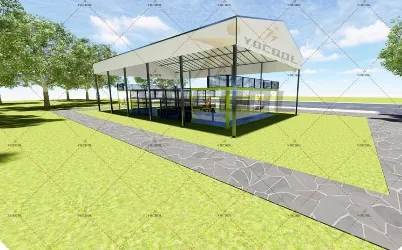

In recent years, padel has emerged as one of the fastest-growing sports across the globe, particularly in Europe, the Middle East, and parts of Latin America. As demand increases, industrial developers, sports facility managers, and municipal planners are investing in high-performance padel court infrastructure. Whether for commercial clubs or public recreation areas, the ability to build padel court structures tailored to specific site conditions has become a competitive advantage. These courts not only enhance user experience but also provide an attractive return on investment for sports complexes looking to diversify their offerings.

Before committing to a new installation, evaluating the padel court price is essential for accurate project planning. This cost varies depending on several industrial factors, including surface type, structural design, enclosure materials, lighting systems, and drainage infrastructure. For developers aiming at long-term ROI, it is vital to prioritize courts that meet international padel standards. Rather than choosing the cheapest option, assessing the price in the context of lifecycle value and maintenance cost ensures financial sustainability. In industrial terms, a well-constructed padel court minimizes operational downtime and provides long-term use with minimal repair needs.
Suppliers offering padel court for sale packages are capitalizing on growing international interest by providing ready-to-install courts designed for large-scale rollout. These industrial solutions come pre-engineered for quick assembly and compliance with technical regulations. In addition to steel and tempered glass structures, most courts include shock-absorbent flooring, integrated lighting poles, and anchoring systems suitable for various substrates. Facility developers in industrial parks, resorts, or urban centers are leveraging these off-the-shelf packages to speed up construction timelines without sacrificing quality. Investing in a complete package simplifies logistics, reduces labor cost, and accelerates the court’s operational readiness.
To build a padel court efficiently, industrial planners must take into account site preparation, surface leveling, and the engineering of load-bearing substructures. A flat and stable foundation is crucial, especially in regions prone to ground movement or waterlogging. The steel framework supporting the tempered glass walls must be corrosion-resistant and capable of handling high wind loads. In industrial zones, integrating the court within existing electrical and water systems further enhances operational convenience. Proper drainage design also prevents surface damage and ensures that the court remains usable year-round. An engineering-first approach results in a durable, functional sports asset.
When calculating the cost to build a padel court, industrial developers should consider not only raw materials and labor but also logistical and regulatory factors. Complying with sports facility codes, environmental regulations, and accessibility standards can increase upfront investment but significantly reduce future liabilities. The cost also includes auxiliary features such as fencing, access pathways, LED lighting, and optional roofing for all-weather play. In many industrial applications, builders are now incorporating solar-powered lighting systems to reduce long-term utility expenses. Each of these additions impacts the total cost, but they also enhance the commercial viability of the court in large-scale facilities.
Industrial-grade materials such as hot-dip galvanized steel, reinforced aluminum frames, and anti-UV acrylic coatings extend the life of padel courts. Choosing high-grade synthetic turf or epoxy resin floors can also significantly reduce maintenance frequency and costs. These materials may raise the initial price but offer better resistance to wear, weather, and player traffic, which is critical for high-volume public or commercial use.
When integrating padel courts into industrial environments, planners often neglect utility layout, traffic flow, and future expansion capacity. Proper site planning allows for smoother utility routing, easier crowd control, and faster maintenance access, all of which reduce long-term operating costs. Factoring in these logistics during the planning stage ensures the facility functions efficiently from day one.
For industrial sports complexes or city-scale installations, scalability is a key factor. Modular designs allow investors to start with one or two courts and expand over time. Courts built with prefabricated, stackable frames allow faster deployment across multiple sites and simplified transport and setup logistics. This modularity is highly attractive for organizations seeking to standardize construction across locations or phases.
Q: What is the average padel court price for commercial use?
A: On average, a fully-equipped industrial-grade padel court ranges between $15,000 and $40,000, depending on surface quality, structural features, and additional systems like lighting and drainage.
Q: Are there padel court for sale packages suitable for industrial deployment?
A: Yes, many manufacturers offer turnkey padel court solutions that are pre-certified and designed for large-scale installation, making them ideal for sports venues, universities, or urban sports parks.
Q: How long does it take to build a padel court in an industrial facility?
A: With proper site preparation and prefabricated systems, most industrial padel courts can be built within 2 to 4 weeks, including lighting and fencing installations.
Q: What is the expected maintenance cost after you build a padel court?
A: Annual maintenance typically ranges from $1,000 to $2,000, covering cleaning, surface checks, net replacement, and minor repairs. Using industrial-grade components can reduce these costs over time.
Q: What are the main variables influencing the cost to build a padel court in an industrial context?
A: Variables include the choice of surface material, the need for custom foundations, location accessibility, compliance with safety standards, and whether roofing or lighting systems are included in the plan.
Starts with Strategic Padel Court Solutions
Sports Facilities with Innovative Padel Court Construction
Revolutionize Sports Facilities with Custom Padel Court Construction
Master Industrial Racquetball Performance with Professional Equipment
Industrial Expansion Begins with Strategic Padel Court Construction Investments
Construct Future-Ready Sports Facilities with Industrial-Grade Padel Courts